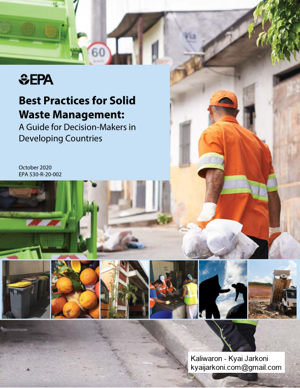Oct 20, 2020 — A Guide for Decision-Makers in Developing Countries operators, and material buyers often contract with the government to perform solid
613 KB – 166 Pages
PAGE – 2 ============
Best Practices for Solid Waste Management: A Guide for Decision-Makers in Developing Countries United States Environmental Protection Agency O˜ce of Resource Conservation and Recovery 2020Notice: Mention of tr ade names, products, resources, or services does not convey, and should not be interpreted as conveying, o˜cial EPA approval, endorsement, or recommendation. Unless otherwise indicated, photos included in this document were obtained by EPA and its contractors, or stock photo aggregators.
PAGE – 3 ============
iContents Case Study List iiiCase-in-Point List . ivKey Point Box List .. vAcronyms and Abbreviations .. viAcknowledgments vii1. Introduction .. 11.1. Sections of the Guide . 41.2. Key Features of the Guide .. 52.Understanding the Need for Solid Waste Managemen t ..72.1. Why Is Solid Waste Management Important? 92.2. Common Challenges 103. Approaches . 153.1. Why Is a Hierarchy of Solid Waste Management Approaches Important? ..173.2. Elements of the Solid Waste Managemen t Hierarchy .174.Stakeholder Engagement . 194.1. Why Involve Stakeholders? . 214.2. Best Practices 225.Planning Systems .. 295.1. Why Is Planning Important for Solid Waste Management Systems? 315.2. Key Steps in Planning .. 316.Economic Considerations . 356.1. Solid Waste Management Costs 376.2. Internal Funding 386.3. External Financing .. 396.4. Contracting with the Private Sector ..426.5. Extended Producer Responsibility ..427.Waste Characterization 477.1. Why Is Waste Characterization Important? .497.2. Best Practices 50
PAGE – 4 ============
ii8.Prevention and Minimization 598.1. What is Waste Prevention and Minimization? .618.2. Why is Waste Prevention and Minimization Important? 618.3. Incorporating Prevention and Minimization into Solid Waste Management ..629.Separation, Collection, and Transportation 659.1. Why Is Collection Important? .. 679.2. Challenges .. 689.3. Best Practices 689.4. Marine Litter .. 7710. Organic Waste Management . 8110.1. What is Organic Waste? .. 8310.2. Why Focus on Organic Waste? 8310.3. Treatment Options . 8410.4. Best Practices 8611. Recycling 9311.1. What Is Recycling? .. 9511.2. Challenges .. 9611.3. Best Practices 9811.4. Informal Sector Recycling 10312.Dumpsite Management . 10712.1. Why Focus on Open Dumpsites? .10912.2. Best Practices 11113.Sanitary Land˚lls 11513.1. What Are Sanitary Land˚lls? . 11713.2. Best Practices 11814.Energy Recovery 12714.1. Why Consider Energy Recovery? ..12914.2. Types of Energy Recovery 12914.3. Challenges .. 13014.4. When to Consider WtE 13115. Bibliography .. 133Appendix A Œ Summary of Key Resources 147Appendix B Œ Region-Speci˚c Resources for Solid Waste Management .151Appendix C Œ Public Engagement/Communications Tools .152
PAGE – 5 ============
iiiCase Study List Exhibit Number Title Page Number 4.3Stakeholder Engagement in Battambang, Cambodia 264.4The Role of Partnerships in Solid Waste Management in Cebu City, Philippines 275.1Disaster Waste Planning in Nepal 346.2Public Private Partnerships in the West Bank and Gaza 457.2Waste Characterization in Naucalpan, Mexico 548.1Food Waste Prevention in Hong Kong 639.7Santos, Brazil™s Door-to-Door Separate Collection Scheme 7910.5Separating and Recycling Organic Waste in La Pintana, Chile 9111.2Using Waste Banks to Process Recyclables in Indonesia 10111.3Independent Waste Recyclers in Ho Chi Minh City, Vietnam 10211.5Incorporating the Informal Sector in Solid Waste Management Activities in Bangalore, India 10612.2Dumpsite Rehabilitation in East Delhi, India 11413.4Developing a Roadmap for Transitioning to a Sanitary Engineered Land˚ll in San Cristobal, Dominican Republic 125
PAGE – 6 ============
ivTitle Page Number Engaging with the Informal Sector in Peru 23Incorporating Solid Waste Management in Primary School Lessons in Cambodia 24Sample Feasibility Studies 33Establishing Variable Collection Fees Tied to Socioeconomic Status 36Climate Bonds for Solid Waste Management 39Extended Producer Responsibility in South Africa 43Kampala, Uganda™s Waste Characterization Study 51Drain Blockage 67Door-to-Door Collection in Trichy, India 69Communal Collection in Addis Ababa, Ethiopia 70Electric Collection Vehicles in Rio de Janeiro, Brazil 75Santa Juana, Chile™s Source Separate Collection 84India™s Solid Waste Management Rules 86São Paulo, Brazil™s Organic Waste Management Strategy 87Composting in Dhaka, Bangladesh 89Tunisia™s Recycling Program 97Brazil™s National Solid Waste Policy 99Incorporating the Informal Sector in Solid Waste Management Activities in Dakar, Senegal 105Closing Open Dumpsites in Oman 112Generating Electricity from Land˚ll Gas in Sao Paulo, Brazil 121Public Private Partnerships in China 130Case in Point List
PAGE – 8 ============
viAcronyms and Abbreviations ADAnaerobic Digestion CBIClimate Bonds Initiative CCAC Climate and Clean Air Coalition CECCommission for Environmental Cooperation EPRExtended Producer Responsibility e-waste Electronic Waste GMIGlobal Methane Initiative Guide Best Practices for Solid Waste Management: A Guide for Decision-Makers in Developing Countries ISWA International Solid Waste Association JSC-H&BJoint Services Council for Hebron and Bethlehem LFGLand˚ll Gas MRFMaterial Recovery Facility NGONongovernmental Organization PETPolyethylene Terephthalate PETCO PET Recycling Company NPC PPPPublic-Private Partnership QRQuick Response S.M.A.R.T. Speci˚c, Measurable, Attainable, Relevant, and Timely UNEPUnited Nations Environment Programme U.S. EPA United States Environmental Protection Agency WtE Waste-to-Energy
PAGE – 9 ============
viiAcknowledgements The United States Environmental Protection Agency™s (U.S. EPA™s) O˜ce of Resource Conservation and Recovery developed the Best Practices for Solid Waste Management: A Guide for Decision-Makers in Developing Countries (Guide) based on U.S. EPA™s long history of supporting solid waste management practices and policies that protect human health and the environment. U.S. EPA received content development, graphical, editorial, and production support from Abt Associates under contract EP-W-10-054, with considerable support from independent consultant Nimmi Damodaran. The following individuals and organizations supported the development of the Guide: U.S. EPA International Organizations Krystal Krejcik United Nations Environment Programme International Environmental Technology Centre (Keith Lia Yohannes Alverson) Brandon Bray German Environment Agency (Anja Schwetje) Chris Cariseullo United Nations Environment Programme (Sandra Swarupa Ganguli Mazo-Nix) Tom Frankiewicz International Solid Waste Association (Aditi Ramola) Stephanie Adrian C40 Cities (Ricardo Cepeda) Andrew Horan The World Bank (Silpa Kaza) Janice Sims Swedish Environmental Protection Agency (Åsa Al Korgi Bergèrus Rensvik) Laura McMillan The Energy and Resources Institute (Sourabh Manuja) Pam Swingle Brazilian Association of Sanitation & Special Waste Chris Newman Companies (Gabriela Otero) Paul Reusch Center for Clean Air Policy (Gerardo Canales) Center for Circular Economy and Climate Change (Goran Vujic) Institute for Global Environmental Strategies (Premakumara Jagath Dickella Gamaralalage) George Mason University (Kuo Tian)
613 KB – 166 Pages
